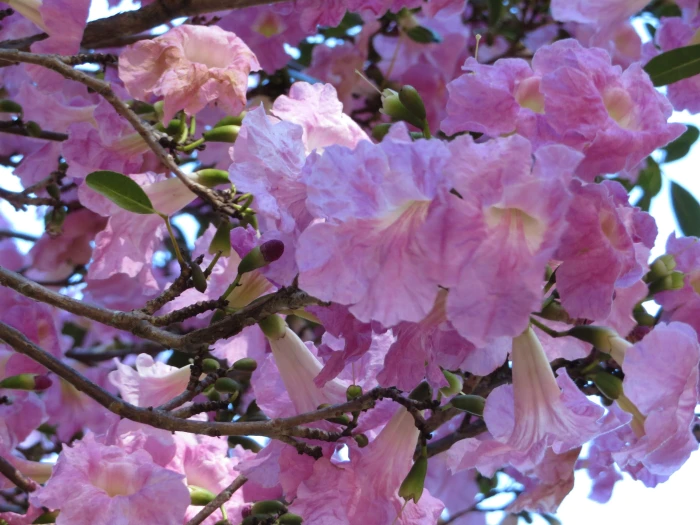Pink Trumpet Tree
(Tabebuia heterophylla)
Pink Trumpet Tree (Tabebuia heterophylla)
/
/

Forest and Kim Starr
CC BY 2.0
Image By:
Forest and Kim Starr
Recorded By:
Copyright:
CC BY 2.0
Copyright Notice:
Photo by: Forest and Kim Starr | License Type: CC BY 2.0 | License URL: https://creativecommons.org/licenses/by/2.0 | Uploader: Josve05a | Publisher: Wikimedia Commons | Title: Starr-170923-0263-Tabebuia_heterophylla-lots_of_flowers-Hawea_Pl_Olinda-Maui_-_Flickr_-_Starr_Environmental.jpg | Notes: {{Information |Description ={{en|1=Location taken: Fairchild Tropical Botanic Garden, Miami, FL USA. Names: Thrinax radiata Lodd. ex Schult. & Schult.f., Broom Palm, Chit, Florid



































































Estimated Native Range
Climate Requirements
| • Precipitation | 49" - 59" |
| • High Temp. | 85°F - 91°F |
| • Low Temp. | 58°F - 74°F |
Summary
Tabebuia heterophylla, commonly known as Pink Trumpet Tree, is a brevi-deciduous tree native to the Caribbean, specifically dry forests and semi-deciduous forests. It typically grows to a height of 20-30 feet (6-9 meters) and is notable for its opposite, palmately compound leaves and clusters of showy, pink to lavender tubular flowers that bloom in spring and early summer. The flowers are highly attractive to hummingbirds and bees. The bark is smooth and light gray, and the tree produces elongated seedpods that split open to release winged seeds.
The Pink Trumpet Tree is valued for its ornamental qualities, including its floral display and its ability to provide light shade. It is commonly used as a street tree or in ornamental plantings in urban and residential areas. This species is adaptable to a range of soil types, provided they are well-drained, and it prefers full sun to partial shade. It is relatively drought-tolerant once established, making it suitable for xeriscaping. While it is cultivated for timber in some regions, its wood is not as commercially important as other Tabebuia species. Potential problems include susceptibility to pests such as aphids and scale insects.CC BY-SA 4.0
The Pink Trumpet Tree is valued for its ornamental qualities, including its floral display and its ability to provide light shade. It is commonly used as a street tree or in ornamental plantings in urban and residential areas. This species is adaptable to a range of soil types, provided they are well-drained, and it prefers full sun to partial shade. It is relatively drought-tolerant once established, making it suitable for xeriscaping. While it is cultivated for timber in some regions, its wood is not as commercially important as other Tabebuia species. Potential problems include susceptibility to pests such as aphids and scale insects.CC BY-SA 4.0
Plant Description
- Plant Type: Tree
- Height: 20-60 feet
- Width: 15-26 feet
- Growth Rate: Rapid
- Flower Color: Pink
- Flowering Season: Spring
- Leaf Retention: Deciduous, Semi-deciduous
Growth Requirements
- Sun: Full Sun, Part Shade
- Water: Low
- Drainage: Fast, Medium
Common Uses
Bird Garden, Butterfly Garden, Drought Tolerant, Erosion Control, Low Maintenance, Showy Flowers, Street Planting
Natural Habitat
Dry forests and semi-deciduous forests in the Caribbean
Other Names
Common Names: Capa Bobo , White cedar , White wood , Pink manjack , Roble Blanco
Scientific Names: Tabebuia heterophylla , Bignonia leucoxylon , Bignonia pentaphylla , Handroanthus pentaphyllus , Leucoxylon acuminata , Leucoxylon riparia , Pilocarpus heterophyllus , Raputia heterophylla , Tabebuia arenicola , Tabebuia beyeri
GBIF Accepted Name: Tabebuia heterophylla